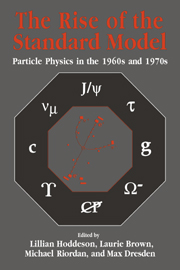Book contents
- Frontmatter
- Contents
- Contributors
- Editors' Acknowledgments
- Photographs of the Symposium
- Abbreviations and Acronyms
- Mathematical Notation
- Part One Introduction
- Part Two Quarks and Leptons
- Part Three Toward Gauge Theories
- 9 The Path to Renormalizability
- 10 Renormalization of Gauge Theories
- 11 Asymptotic Freedom and the Emergence of QCD
- 12 Quark Confinement
- 13 A View from the Island
- 14 On the Early Days of the Renormalization Group
- Part Four Accelerators, Detectors, and Laboratories
- Part Five Electroweak Unification
- Part Six The Discovery of Quarks and Gluons
- Part Seven Personal Overviews
- Index
10 - Renormalization of Gauge Theories
Published online by Cambridge University Press: 03 February 2010
- Frontmatter
- Contents
- Contributors
- Editors' Acknowledgments
- Photographs of the Symposium
- Abbreviations and Acronyms
- Mathematical Notation
- Part One Introduction
- Part Two Quarks and Leptons
- Part Three Toward Gauge Theories
- 9 The Path to Renormalizability
- 10 Renormalization of Gauge Theories
- 11 Asymptotic Freedom and the Emergence of QCD
- 12 Quark Confinement
- 13 A View from the Island
- 14 On the Early Days of the Renormalization Group
- Part Four Accelerators, Detectors, and Laboratories
- Part Five Electroweak Unification
- Part Six The Discovery of Quarks and Gluons
- Part Seven Personal Overviews
- Index
Summary
Like most other presentations by scientists in this Symposium, my account of the most important developments that led toward our present view of the fundamental interactions among elementary particles is a personal one, recounting discoveries I was just about to make when someone else beat me to it. But there is also something else I wish to emphasize. This is the dominant position reoccupied during the last two decades by theory, in its relation to experiment. In particular quantum field theory not only fully regained respectability but has become absolutely essential for understanding those basic facts now commonly known as the “Standard Model.” So much happened here, so many discoveries were made, that the space allotted to theory in this volume runs far too short to cover it all. Therefore, I will limit myself only to the nicest goodies among the many interesting developments in theory, and of those I'll only pick the ones that were of direct importance to me.
Renormalization
Before the seventies there was only one renormalizable quantum field theory that seemed to give a reasonable and useful description of (parts of) the real world: quantum electrodynamics. Its remarkable successes in explaining, among others, the Lamb shift and the anomalous magnetic moment of the electron did not go unnoticed. Yet the idea that other interactions should also be described in the context of renormalizable field theories became less and less popular. Indeed, the notion of renormalizability was quite controversial, and to some it still is.
- Type
- Chapter
- Information
- The Rise of the Standard ModelA History of Particle Physics from 1964 to 1979, pp. 179 - 198Publisher: Cambridge University PressPrint publication year: 1997
- 3
- Cited by



